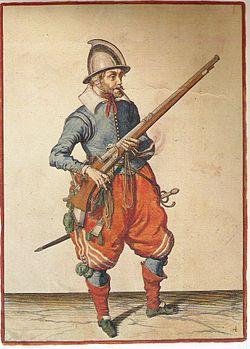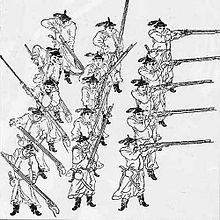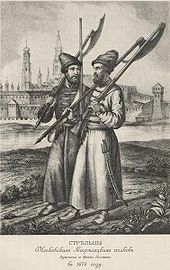- Musketeer
-
A musketeer (French: mousquetaire) was an early modern type of infantry soldier equipped with a musket. Musketeers were an important part of early modern armies, particularly in Europe. They sometimes could fight on horseback, like a dragoon or a cavalryman. The musketeer was a precursor to the rifleman.
Contents
Asia
Musketeers in China
Muskets were used in China at least from the 14th Century. Musketeers were utilized in the Ming Dynasty (1368-1644) and Qing Dynasty (1644-1911). 14th century military book Huolongjing already describe Chinese matchlock. In Zhao Shizhen's book of 1598 AD, the Shenqipu, there were illustrations of Ottoman Turkish riflemen with detailed illustrations of their muskets, alongside European musketeers with detailed illustrations of their muskets.[1] There was also illustration and description of how the Chinese had adopted the Ottoman kneeling position in firing while favoring European-made rifles.[2] The Chinese also built the first repeating fire-arm, several barrels behind a small wooden shield, the musketeer would turn the barrels and light each barrel with a slow match one by one. These weapons were most effective being fired from walls or high positions.
Musketeers in the Ottoman Empire
The famous Janissary corps of the Ottoman army were using matchlock muskets as early as the 1440s.[3] The Ottoman Empire, centering around Turkey and extending into Arabia, used muskets to conquer Constantinople (modern Istanbul) and were one of the earliest users of muskets in a military conflict. It also utilized large cannons, the Great Turkish Bombard and incindernary devices. They are also probably the first to use muskets aboard ships.
Musketeers in India
Musket warfare became an integral part of Indian warfare when they were introduced to India by the Moghuls in 1519. They were an important defense against the tank-like War Elephants. Both the Mughals and Indians (such as the Sikhs, Rajputs and Marathas) used musketeers in cover formations while sending volleys of musket fire on unsuspecting soldiers, horses, and elephants. Many Indian gunsmiths existed during the 18th and 17th century, creating regular muskets and some combination weapons.
Europe
Musketeers in Spain
In the Spanish army, the Tercio (sometimes referred to by other nations as a Spanish Square) was a mixed infantry formation of up to 3,000 pikemen, swordsmen and musketeers. It was nigh on invincible in its era, capitalizing on the brute strength and close-range abilities of the pikemen and the long-range projectile capabilities of the muskets. In practice, it appeared as a loosely formed phalanx in function, but was far more flexible and deadly. The musketeer manned tercios were developed from the earlier arquebusier manned coronelias which had firmly established their fearsome reputation by defeating the French at the Battle of Pavia in 1525 and capturing their king.
Musketeers in Russia
Streltsy (Russian: Стрельцы) were the units of Russian guardsmen (sl. strelets, стрелец. literally "shooter"; often translated as "musketeer," but more properly "harquebusier") in the 16th - early 18th centuries, armed with firearms (riflemen). They are also collectively known as Strelets Troops (Стрелецкое Войско).
The first strel'tsy units were created by Ivan the Terrible sometime between 1545 and 1550 and armed with the arquebus. They first saw combat at the Siege of Kazan in 1552. Military service in this unit became lifelong and hereditary.
The Muscovite government was chronically short of cash so that the strel'tsy were often not paid well. While "entitled" to something like four rubles a year in the 1550s, they were often allowed to farm or trade in order to supplement their incomes.
In the late 17th century, Streltsy of Moscow began to actively participate in a struggle for power between different government groups, supporting the dissidents and showing hostility towards any foreign innovations.
After the fall of Sophia Alekseyevna in 1689, the government of Peter the Great engaged in a process of gradual limitation of Streltsy’s military and political influence.
In spite of these measures, the strel'tsy revolted yet again while Peter was on his Great Embassy in Europe. The corps was technically abolished in 1689; however, after having suffered a defeat at Narva in 1700, the government stopped their disbandment.
Gradually, Streltsy were incorporated into the regular army. At the same time, they started to disband the Municipal Streltsy. Liquidation of the streltsy units was finally finished only in the 1720s, however, the Municipal Strel'tsy were kept in some cities until the late 18th century.
The Preobrazhensky and Izmailovsky regiments of Imperial Guards replaced the strel'tsy as the tsar's bodyguards.
Musketeers in France
The Musketeers of the Guard were a junior unit of roughly company strength of the military branch of the Royal Household or Maison du Roi. They were created in 1622 when Louis XIII furnished a company of light cavalry (the "carabiniers", created by Louis' father Henry IV) with muskets. Musketeers fought in battle both on foot (infantry) and on horseback (dragoons).[citation needed] As a junior unit in the Royal Guard, the Musketeers were not closely linked to the royal family. Traditional bodyguard duties were in fact performed by the Garde du Corps and the Gardes suisses. Because of its junior status, the Musketeers were open to the lower classes of French nobility or younger sons from noble families whose oldest son served in the more prestigious units. The Musketeers soon gained a reputation for boisterousness and fighting spirit because the only way for social and career advancement was excelling at their task as mounted light dragoons.
Their high esprit de corps and can-do attitude gained them royal favour and they became a popular fixture at court and in Paris. Shortly after their creation, Cardinal Richelieu created a bodyguard unit for himself. So as not to offend the King with a perceived sense of self-importance, Richelieu did not name them Garde du Corps like the King's personal guards but rather Musketeers after the Kings' junior guard cavalry. This was the start of a bitter rivalry between both corps of Musketeers. At the cardinal's death in 1642, the company passed to his successor Cardinal Mazarin. At Mazarin's death in 1661, the cardinal's Musketeers passed to Louis XIV to the disgust of both the King's Musketeers and the Cardinal's Musketeers. The Musketeers were subsequently reorganized as a guard cavalry regiment of two companies. The King's Musketeers became the first company, popularly known as "Grey Musketeers" (mousquetaires gris) while the Cardinal's Musketeers became the second company, known as "Black Musketeers" (mousquetaires noirs) for riding grey and black horses, respectively.
The Musketeers were among the most popular of the military companies of the Ancien Régime. This popularity was due to the lower entrance requirements. The senior guard units were in effect closed to all but the most senior and wealthy of French nobles, so for the vast majority of French nobles (many of whom lived in genteel poverty), service in the Musketeers was the only way to join a cavalry unit in the Royal Household and perhaps catch the King's eye.
In 1776, the Musketeers were eliminated by Louis XVI, for budgetary reasons. Reformed in 1789, they were eliminated shortly afterward. They were reformed on July 6, 1814, and definitively eliminated on January 1, 1816.
Decades later, starting in 1844, this group was the subject of the now-famous serial publication The Three Musketeers, in the magazine Le Siècle between March and July 1844. The author, Alexandre Dumas, père, based his work on the book Mémoires de Monsieur d'Artagnan, capitaine lieutenant de la première compagnie des Mousquetaires du Roi (Memoirs of Mister d'Artagnan, Lieutenant Captain of the first company of the King's Musketeers) by Gatien de Courtilz de Sandras (Cologne, 1700).
Musketeers in Sweden
Thanks to the reforms of Gustav II Adolf of Sweden, the Swedish Army brought to maturity the new style of fighting that made Sweden into a great power in the 17th century. This style of fighting became the new standard throughout Europe and its colonies in the latter stages of musket dominated warfare. Manuals based on Gustav's own revolutionised the training and tactics of western armies.
Musketeers in Britain
The iconic "Redcoat" of the British Empire was the staple unit in the British armies that created the largest empire in history. Originally worn only by British soldiers, it was adopted by the British East India Company and given to sepoys in India. The facing of the jacket was a variety of colours, depending on the regiment. The redcoat was equipped with the .75 calibre Land Pattern Musket, or Brown Bess. He was the most thoroughly trained musketeer in history, the British army being the only one in the colonial era to train with live ammunition. A fully trained redcoat could fire four times a minute. This, combined with the British technique of firing by companies (a method wherein blocks of men fired smaller volleys in succession, creating a wave of fire down the front of the regiment), made it possible for the British to win pitched battles against far superior numbers.
Musketeers in Poland
The photo to the lower right shows examples of how the 18th century Musketeers from Swidnica appeared.
See also
- The Three Musketeers (disambiguation), and Alexandre Dumas, père's classic novel The Three Musketeers
- Various military operations named Operation Musketeer
- Fusilier
- Rifleman
- Pike and shot
- Line infantry
- Foot Guards
- Some Notable Musketeers
-
- Thomas de Treil de Pardailhan
- Monsieur de Tréville
- D'Artagnan
- Bénigne Dauvergne de Saint-Mars
- Jean-François Leriget de La Faye
- Charles François de Froulay
- François-Henri de Franquetot de Coigny
- Pierre de Montesquiou d'Artagnan
- Alexandre François Marie de Beauharnais
- Germain-François Poullain de Saint-Foix
- Louis II Sanguin
- Louis de Rouvroy, duc de Saint-Simon
- Cyrano de Bergerac
Gallery
-
Musketeer from Altblau regiment (1624-1650) from Swedish army with musket and with bardiche (long poleaxe)
-
18th century musketeers from Świdnica (reconstruction)
Notes
Sources
- Needham, Joseph, et al., Science and Civilisation in China: volume 5, Part 7: Military Technology: The Gunpowder Epic, New York, Cambridge University Press, 1986
- This article is based in part on the article Mousquetaire from the French Wikipedia, retrieved on September 9, 2006.
Wikimedia Foundation. 2010.

















